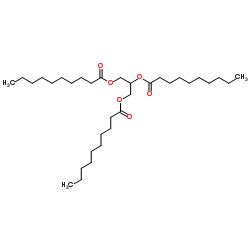Tricaprin

Tricaprin structure
|
Common Name | Tricaprin | ||
|---|---|---|---|---|
| CAS Number | 621-71-6 | Molecular Weight | 554.842 | |
| Density | 0.9±0.1 g/cm3 | Boiling Point | 578.6±17.0 °C at 760 mmHg | |
| Molecular Formula | C33H62O6 | Melting Point | 31-32 °C | |
| MSDS | USA | Flash Point | 233.3±21.0 °C | |
| Symbol |


GHS02, GHS07 |
Signal Word | Danger | |
|
Chain length affects pancreatic lipase activity and the extent and pH-time profile of triglyceride lipolysis.
Eur. J. Pharm. Biopharm. 93 , 353-62, (2015) Triglycerides (TG) are one of the most common excipients used in oral lipid-based formulations. The chain length of the TG plays an important role in the oral bioavailability of the co-administered drug. Fatty acid (FA) chain-length specificity of porcine pan... |
|
|
Surface properties of artificial tear film lipid layers: effects of wax esters.
Invest. Ophthalmol. Vis. Sci. 55(7) , 4448-54, (2014) The tear film lipid layer is believed to stabilize the tear film and to retard evaporation. Based on previous simple in vitro studies, the evidence for the latter property is scarce. In this study, we used complex lipid mixtures including various wax esters t... |
|
|
Effect of additives on the release of a model protein from PLGA microspheres.
AAPS PharmSciTech 2(4) , 30, (2001) The purpose of this study was to investigate the effect of 2 additives, poly(ethylene glycol) (PEG) 1000 and 1,2,3-tridecanoyl glycerol (tricaprin), on the physico-chemical characteristics and in vitro release of a model protein, bovine serum albumin (BSA), f... |
|
|
Medium-chain triacylglycerols enhance release of cholecystokinin in chicks.
J. Nutr. 122(8) , 1702-5, (1992) Whether medium-chain triacylglycerols (MCT) affect the plasma concentration of cholecystokinin (CCK) and crop-emptying rate in chicks was investigated after 0, 30, 60, 90, 120 or 180 min of diet intubation. Triacylglycerol sources used were corn oil [containi... |
|
|
Formulation parameters determining the physicochemical characteristics of solid lipid nanoparticles loaded with all-trans retinoic acid.
Int. J. Pharm. 243(1-2) , 135-46, (2002) Solid lipid nanoparticles (SLNs) have gained attention as a colloidal drug carrier, particularly for drugs with limited solubility. The poor aqueous solubility of all-trans retinoic acid (ATRA) has been a limiting factor in its clinical use. This study was un... |
|
|
Solid lipid nanoparticles as delivery systems for bromocriptine.
Pharm. Res. 25(7) , 1521-30, (2008) The present investigation describes a formulative study for the development of innovative drug delivery systems for bromocriptine.Solid lipid nanoparticles (SLN) based on different lipidic components have been produced and characterized. Morphology and dimens... |
|
|
Evolution of fat crystal network microstructure followed by NMR.
J. Agric. Food Chem. 59(5) , 1767-73, (2011) Model systems composed of tristearin in solid state and tricaprin in liquid state with different solid-fat content (SFC) and storage time have been investigated by relaxation NMR and NMR diffusometry. The T(2) relaxation of the tricaprin in the melt exhibited... |
|
|
[Effect of short- or medium-chain fatty acids on cholesterol dynamics in the rat].
Ann. Nutr. Metab. 27(2) , 162-71, (1983) The effects of a diet consisting of 10% medium-chain triglycerides (C8:0, C10:0) or 10% homogeneous triglycerides of 6- to 14-carbon chain saturated fatty acids on cholesterol turnover processes were studied in rats using the isotope equilibrium method. Chole... |
|
|
Preexercise medium-chain triglyceride ingestion does not alter muscle glycogen use during exercise.
J. Appl. Physiol. 88(1) , 219-25, (2000) This investigation determined whether ingestion of a tolerable amount of medium-chain triglycerides (MCT; approximately 25 g) reduces the rate of muscle glycogen use during high-intensity exercise. On two occasions, seven well-trained men cycled for 30 min at... |
|
|
Physical behavior of lipase substrates.
Meth. Enzymol. 286 , 153-67, (1997)
|